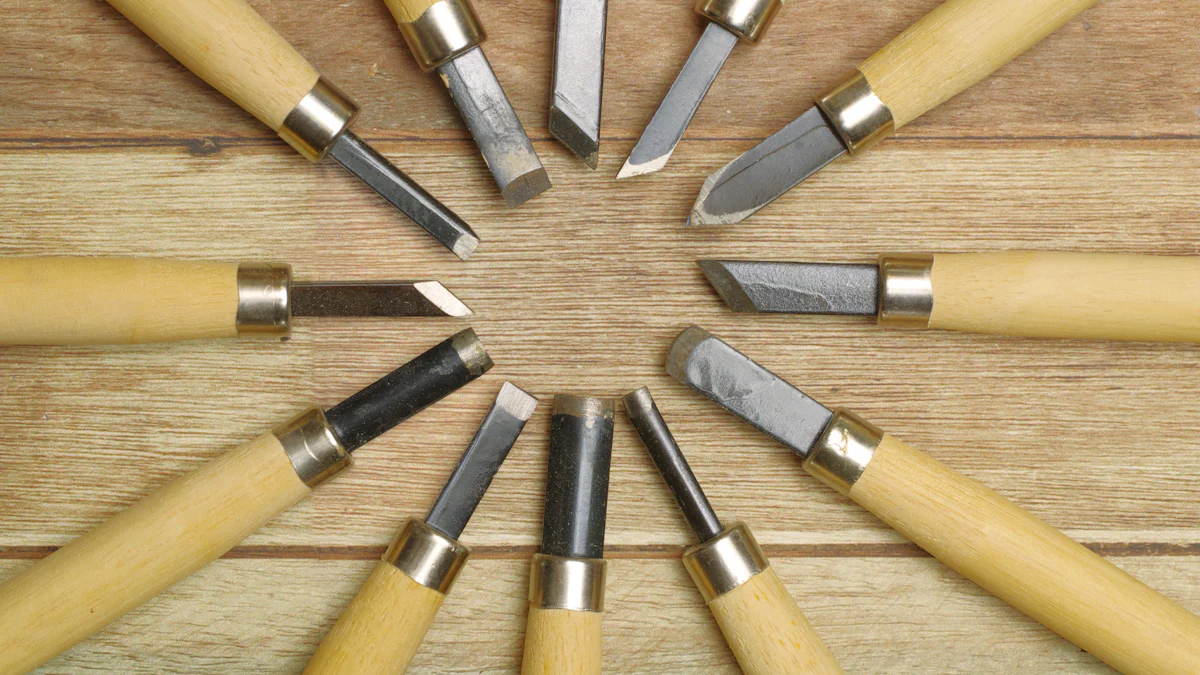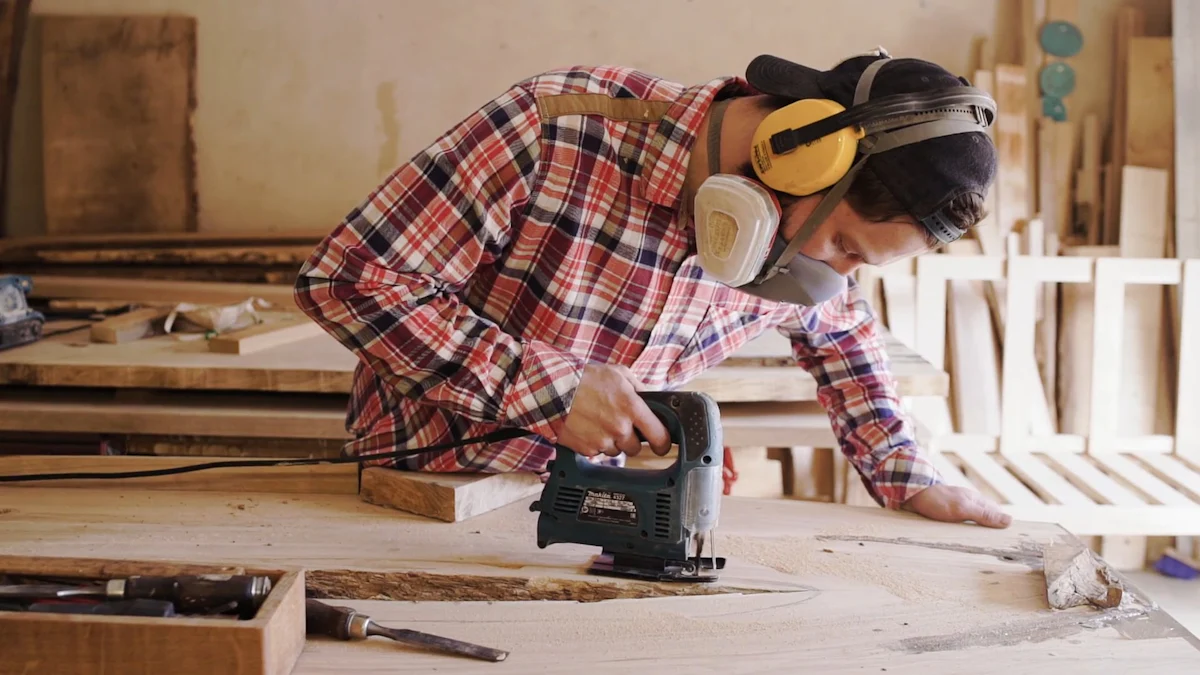
Having the right tools for cutting wood is essential for any craft project. Woodworking enthusiasts know the satisfaction of creating beautiful, functional objects. A wide variety of tools exists, each with specific uses. From hand saws to power saws, each tool plays a crucial role in shaping and cutting wood. This blog aims to educate readers on the top wood cutting tools for craft projects, ensuring both beginners and seasoned woodworkers can make informed choices.
Types of Wood Cutting Tools

Hand Saws
Coping Saw
The coping saw excels at cutting intricate shapes and curves in wood. This tool features a thin, narrow blade held under tension by a U-shaped frame. The coping saw’s design allows for precise control, making it ideal for detailed craft projects. Woodworkers often use the coping saw to create joints, cut moldings, and perform other fine woodworking tasks.
Japanese Saw
The Japanese saw, known for its unique pull-stroke cutting action, offers exceptional precision and control. Unlike Western saws that cut on the push stroke, the Japanese saw cuts as the user pulls the blade toward themselves. This method reduces the risk of the blade binding in the wood, resulting in cleaner, more accurate cuts. The Japanese saw is perfect for detailed joinery and delicate woodworking tasks.
Power Saws
Jigsaw
The jigsaw stands out among power tools for cutting wood due to its versatility. Equipped with a reciprocating blade, the jigsaw can make straight, curved, and intricate cuts. Users can adjust the blade speed and angle to suit various materials and cutting requirements. The jigsaw is particularly useful for cutting out shapes and patterns in wood, making it a favorite among craft enthusiasts.
Circular Saw
The circular saw is a powerful tool designed for making quick, straight cuts in wood. Featuring a rotating toothed blade, the circular saw can handle a variety of cutting tasks, from ripping lumber to cross-cutting boards. Different blade types, such as carbide, steel, and diamond-tipped, cater to specific cutting needs. The circular saw’s efficiency and speed make it an essential tool for both novice and experienced woodworkers.
Specialty Saws
Scroll Saw
The scroll saw specializes in making intricate and detailed cuts. With its fine blade and ability to cut tight curves, the scroll saw is ideal for creating delicate patterns and designs in wood. The tool’s variable speed control allows users to adjust the cutting speed to match the material and complexity of the project. Craft enthusiasts often use the scroll saw for marquetry, intarsia, and other decorative woodworking techniques.
Band Saw
The band saw is a versatile tool known for its ability to cut both straight and curved lines in wood. Featuring a continuous looped blade, the band saw can handle a wide range of cutting tasks, from resawing thick lumber to making precise cuts in thin pieces of wood. The band saw’s adjustable table and blade guides provide stability and accuracy, making it a valuable addition to any woodworking shop.
Other Essential Tools
Chisels
Chisels serve as indispensable tools for cutting wood with precision. Woodworkers use chisels to carve, shape, and smooth wood surfaces. Different types of chisels, such as bench chisels and mortise chisels, cater to various woodworking tasks. A sharp chisel ensures clean cuts and detailed work, making it a must-have in any woodworking toolkit.
Axes
Axes stand out as versatile tools for cutting wood, especially larger pieces. Woodworkers rely on axes for splitting logs and shaping timber. The design of an axe, with its heavy head and long handle, provides the leverage needed for efficient woodcutting. Maintaining a sharp edge on the axe blade is crucial for optimal performance.
Adze
The adze is a specialized tool used for shaping wood by removing thin layers. Woodworkers employ the adze for tasks requiring a curved or hollowed surface. The adze features a blade set at a right angle to the handle, allowing for controlled, sweeping cuts. This tool proves essential for traditional woodworking techniques and historical restorations.
Planes
Planes are essential tools for smoothing and shaping wood surfaces. Woodworkers use planes to remove thin shavings of wood, achieving a flat and even finish. Different types of planes, such as block planes and smoothing planes, address specific tasks. A well-tuned plane with a sharp blade ensures precise and efficient woodwork.
Spokeshave
The spokeshave excels at shaping and smoothing curved wood surfaces. Woodworkers use spokeshaves for tasks like crafting chair legs and wheel spokes. The tool’s design, featuring a blade held between two handles, allows for fine control over the cutting action. A sharp blade and proper adjustment make the spokeshave a valuable addition to any woodworking shop.
Routers
Routers are versatile tools for cutting wood, shaping, and hollowing out areas. Woodworkers use routers to create intricate designs, grooves, and edges. The router’s adjustable depth and interchangeable bits provide flexibility for various projects. A router’s precision and versatility make it an essential tool for both novice and experienced woodworkers.
Wood Carving Knives
Wood carving knives are specialized tools for intricate wood cutting and carving. Woodworkers use these knives to create detailed patterns and sculptures. Different blade shapes and sizes cater to various carving techniques. A sharp wood carving knife ensures clean cuts and fine details, making it indispensable for craft projects.
Criteria for Selecting Wood Cutting Tools
Project Requirements
Type of Wood
Different types of wood require specific tools for cutting wood. Hardwoods like oak and maple need robust tools to handle their density. Softwoods such as pine and cedar can be cut with lighter tools. Choosing the right tool ensures clean cuts and prevents damage to the wood. For example, a Japanese saw works well with softwoods due to its pull-stroke action. Conversely, a circular saw with a carbide blade handles hardwoods effectively.
Precision Needed
Precision plays a crucial role in selecting tools for cutting wood. Projects requiring intricate details benefit from tools like the scroll saw or coping saw. These tools offer fine control for detailed work. For larger, less detailed cuts, a band saw or jigsaw provides the necessary power and flexibility. Precision also depends on the user’s skill level. Beginners might prefer tools that offer more control and safety features.
Tool Features
Blade Quality
Blade quality significantly impacts the performance of tools for cutting wood. High-alloy carbon steel blades provide durability and sharpness. Tools like chisels and hand planes require sharp blades for precise cuts. A dull blade can lead to rough edges and increased effort. Regular maintenance, including sharpening, ensures optimal performance. For power tools, carbide-tipped blades offer longevity and efficiency.
Ergonomics
Ergonomics affect the ease of use and comfort when using tools for cutting wood. Tools with ergonomic handles reduce strain and improve control. For instance, spokeshaves with well-designed handles allow for smooth, controlled movements. Power tools with adjustable features cater to different hand sizes and grips. Ergonomic design enhances safety by reducing fatigue and the risk of accidents.
Maintenance of Wood Cutting Tools
Cleaning
Regular Cleaning
Regular cleaning ensures wood cutting tools remain in optimal condition. Dust and debris accumulate on tools after each use. A soft brush or cloth removes loose particles. For stubborn dirt, a mild soap solution works effectively. Drying tools thoroughly prevents rust formation. Regular cleaning extends the lifespan of tools and maintains their performance.
Deep Cleaning
Deep cleaning involves more thorough methods. Disassembling tools allows access to hard-to-reach areas. Soaking parts in a cleaning solution loosens grime and resin buildup. Scrubbing with a wire brush removes stubborn residues. After cleaning, applying a light coat of oil protects metal surfaces from corrosion. Deep cleaning should occur periodically, especially for heavily used tools.
Sharpening
Hand Saw Sharpening
Sharpening hand saws requires precision. A saw file matches the teeth’s size and shape. Clamping the saw in a vise provides stability. Filing each tooth individually restores sharpness. Consistent filing angle ensures uniform teeth. Regular sharpening keeps hand saws efficient and reduces cutting effort.
Power Saw Blade Sharpening
Power saw blades need specialized sharpening equipment. Removing the blade from the saw ensures safety. A diamond wheel grinder sharpens carbide-tipped blades. Adjusting the grinder’s angle matches the blade’s original bevel. Evenly grinding each tooth maintains balance. Professional sharpening services offer convenience for those without the necessary equipment. Regular sharpening enhances cutting performance and prolongs blade life.
Safety Tips for Using Wood Cutting Tools

Personal Protective Equipment (PPE)
Safety Glasses
Safety glasses protect the eyes from flying wood chips and dust. Woodworkers must wear safety glasses at all times when cutting wood. Clear lenses provide visibility while ensuring protection. For additional safety, wrap-around designs shield the sides of the eyes. Regular cleaning maintains clear vision and effectiveness.
Gloves
Gloves safeguard hands from cuts, splinters, and abrasions. Woodworkers should choose gloves made from durable materials. Leather or cut-resistant gloves offer optimal protection. Properly fitting gloves ensure dexterity and control. Regular inspection helps identify wear and tear, ensuring continued safety.
Safe Operating Practices
Proper Handling
Proper handling of wood cutting tools prevents accidents. Woodworkers must always use both hands to control the tool. Firm grips reduce the risk of slipping. Keeping fingers away from the cutting path ensures safety. Woodworkers should always cut on a stable surface to prevent movement. Regular practice improves handling skills and confidence.
Safe Storage
Safe storage of wood cutting tools maintains their condition and prevents injuries. Tools should be stored in a dry environment to avoid rust. Hanging tools on a pegboard keeps them organized and accessible. Protective sheaths or covers prevent accidental contact with sharp edges. Regular maintenance, such as polishing teeth and oiling metal parts, extends the lifespan of tools.
Choosing the right wood cutting tools for craft projects ensures precision and efficiency. Following the selection criteria, maintenance tips, and safety guidelines provided in this blog enhances the woodworking experience. Proper tools and techniques contribute to successful and enjoyable projects. Readers are encouraged to share experiences and tips in the comments section. Engaging with the community fosters learning and improvement.
See Also
Scooter Upgrades: High-Quality Parts for Maximum Performance
Winter Bliss: Stay Warm and Cozy with Soft Socks
Dive into Diverse Sock Options for Both Genders
